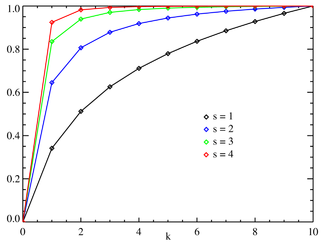Zipf's law
|
Probability mass function
 Zipf PMF for N = 10 on a log–log scale. The horizontal axis is the index k . (Note that the function is only defined at integer values of k. The connecting lines do not indicate continuity.) |
|
|
Cumulative distribution function
 Zipf CDF for N = 10. The horizontal axis is the index k . (Note that the function is only defined at integer values of k. The connecting lines do not indicate continuity.) |
|
| Parameters |
(real) (integer) |
|---|---|
| Support | |
| pmf | where HN,s is the Nth generalized harmonic number |
| CDF | |
| Mean | |
| Mode | |
| Entropy | |
| MGF | |
| CF | |
Zipf's law /ˈzɪf/ is an empirical law formulated using mathematical statistics that refers to the fact that many types of data studied in the physical and social sciences can be approximated with a Zipfian distribution, one of a family of related discrete power law probability distributions. The law is named after the American linguist George Kingsley Zipf (1902–1950), who popularized it and sought to explain it (Zipf 1935, 1949), though he did not claim to have originated it. The French stenographer Jean-Baptiste Estoup (1868–1950) appears to have noticed the regularity before Zipf. It was also noted in 1913 by German physicist Felix Auerbach (1856–1933).
Zipf's law states that given some corpus of natural language utterances, the frequency of any word is inversely proportional to its rank in the frequency table. Thus the most frequent word will occur approximately twice as often as the second most frequent word, three times as often as the third most frequent word, etc.: the rank-frequency distribution is an inverse relation. For example, in the Brown Corpus of American English text, the word "the" is the most frequently occurring word, and by itself accounts for nearly 7% of all word occurrences (69,971 out of slightly over 1 million). True to Zipf's Law, the second-place word "of" accounts for slightly over 3.5% of words (36,411 occurrences), followed by "and" (28,852). Only 135 vocabulary items are needed to account for half the Brown Corpus.
...
Wikipedia










